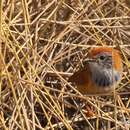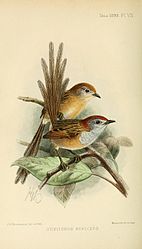zh-TW
在導航的名稱


Stipiturus a zo ur genad e rummatadur an evned, krouet e 1831 gant an naturour gall René Primevère Lesson (1794-1849).
Tri spesad golvaneged a ya d'ober ar genad :
Eizh (8) isspesad en holl : o c'havout a reer en Aostralia.
a vo kavet e Wikimedia Commons.
Stipiturus a zo ur genad e rummatadur an evned, krouet e 1831 gant an naturour gall René Primevère Lesson (1794-1849).
Stipiturus és un gènere d'ocells de la família dels malúrids (Maluridae ).
Segons la Classificació del Congrés Ornitològic Internacional (versió 2.5, 2010) aquest gènere està format per tres espècies:
The emu-wrens (Stipiturus) are a genus of passerine birds in the Australasian wren family, Maluridae. They are found only in Australia, where they inhabit scrub, heathland and grassland. They are small birds, 12–19 cm long with the tail accounting for over half of their length. The tail has only six feathers which are loose and coarse in structure, rather like the feathers of the emu. Three species are recognised, of which the mallee emu-wren is endangered.
The common name of the genus is derived from the resemblance of their tails to the feathers of an emu.[1] The genus was defined by French naturalist René Lesson in 1831 after his visit to Port Jackson on the 1823-5 voyage of the Coquille, although the southern emu-wren had already been encountered and described soon after European settlement at Sydney Cove.[2] The three species have been variously considered as one, two or even four species (as the Western Australian subspecies westernensis of the southern emu-wren also considered a species at one point.[3] Their closest relative, based on allozyme studies, appears to be the orange-crowned fairywren of the monotypic genus Clytomyias from the mountains of New Guinea.[4]
There are three recognised species in the genus:[5]
Ornithologist Richard Schodde has proposed that the southern emu-wren is the ancestral form from which the other two species have evolved.
Emu-wrens exhibit sexual dimorphism, the males have brownish plumage with rufous crowns of varying intensity, and a sky blue throat and upper chest. The females lack the blue coloration and are predominantly reddish brown above and paler below. Their most distinctive feature is their long tails, composed of six filamentous feathers, the central two longer again. The tail is double the body length in the case of the southern and rufous-crowned species. They weigh from 5.4 g in the case of the smallest, the rufous-crowned, to 7.5 g of the southern emu-wren.[6]
The three species of emu-wrens each live in distinct habitats: the southern emu-wren preferring marshes and heathland, the mallee emu-wren inhabiting spinifex understory in mallee woodland, and the rufous-crowned emu-wren dwelling in spinifex in desert areas.
Emu-wrens are fairly secretive and hard to spot, living in low shrub cover. They are predominantly insectivorous, but supplement their diet with seeds.[2] Their furtive behaviour and brown colour has resulted in them being mistaken for bush mice.[1] They exhibit a weak but distinctive flight pattern with the tail feathers drooping noticeably.
The emu-wrens (Stipiturus) are a genus of passerine birds in the Australasian wren family, Maluridae. They are found only in Australia, where they inhabit scrub, heathland and grassland. They are small birds, 12–19 cm long with the tail accounting for over half of their length. The tail has only six feathers which are loose and coarse in structure, rather like the feathers of the emu. Three species are recognised, of which the mallee emu-wren is endangered.
Stipiturus es un género de aves paseriformes perteneciente a la familia Maluridae.[1] Sus miembros son endémicos de Australia.
Las especies y subespecies de este género se encuentran localizadas en Australia.[2][3][4]
Stipiturus es un género de aves paseriformes perteneciente a la familia Maluridae. Sus miembros son endémicos de Australia.
Emumalurit (Stipiturus) on malurien heimoon kuuluva australialainen varpuslintusuku, johon BirdLifen mukaan kuuluu kolme lajia:
Emumalurit (Stipiturus) on malurien heimoon kuuluva australialainen varpuslintusuku, johon BirdLifen mukaan kuuluu kolme lajia:
Isoemumaluri (Stipiturus malachurus) Pikkuemumaluri (Stipiturus ruficeps) Tummaemumaluri (Stipiturus mallee)Stipiturus est un genre d'oiseaux de la famille des Maluridae.
Selon la classification de référence du Congrès ornithologique international (version 6.4, 2016)[1] :
Stipiturus is een geslacht van zangvogels uit de familie elfjes (Maluridae).
Het geslacht kent de volgende soorten:[1]
Stipiturus is een geslacht van zangvogels uit de familie elfjes (Maluridae).
Stipiturus (emusmetter) er en slekt i alvesmettfamilien (Maluridae) og tilhører gruppen av sangfugler (Passeri), som er spurvefugler (Passeriformes). Slekten sorterer i underfamilien Malurinae og blir av og til inkludert i et tribus (Stipiturini) for seg selv. Den inkluderer tre arter med små insektetende fugler med lange ben og lang stjert. Stjerten har kun seks halefjær som er løst formet. Artene er endemiske for Australia. Slekten er én av seks slekter i alvesmettfamilien, som deles inn i to underfamilier.
Inndelingen følger HBW Alive og er i henhold til Rowley & Russell (2017).[1] Norske navn på artene følger Norsk navnekomité for fugl og er i henhold til Syvertsen et al. (2008).[2] Norske navn i parentes er ikke offisielle navn, men kun en foreløpig beskrivelse på en art eller gruppe som ikke har blitt offisielt navngitt enda.
Stipiturus (emusmetter) er en slekt i alvesmettfamilien (Maluridae) og tilhører gruppen av sangfugler (Passeri), som er spurvefugler (Passeriformes). Slekten sorterer i underfamilien Malurinae og blir av og til inkludert i et tribus (Stipiturini) for seg selv. Den inkluderer tre arter med små insektetende fugler med lange ben og lang stjert. Stjerten har kun seks halefjær som er løst formet. Artene er endemiske for Australia. Slekten er én av seks slekter i alvesmettfamilien, som deles inn i to underfamilier.
Stipiturus – rodzaj ptaka z podrodziny chwostek (Malurinae) w rodzinie chwostkowatych (Maluridae).
Rodzaj obejmuje gatunki występujące w Australii[3].
Długość ciała 10–19 cm; masa ciała 5–9 g[4].
Stipiturus: łac. stipes, stipitis – gałąź, konar; gr. ουρα oura – ogon[5].
Do rodzaju należą następujące gatunki[6]:
Stipiturus – rodzaj ptaka z podrodziny chwostek (Malurinae) w rodzinie chwostkowatych (Maluridae).
Stipiturus é um gênero de ave da família Maluridae.
Emusmygar (Stipiturus) är ett fågelsläkte i familjen blåsmygar inom ordningen tättingar.[1] Arterna i släktet förekommer enbart i Australien. Släktet omfattar endast tre arter:[1]
Emusmygar (Stipiturus) är ett fågelsläkte i familjen blåsmygar inom ordningen tättingar. Arterna i släktet förekommer enbart i Australien. Släktet omfattar endast tre arter:
Sydlig emusmyg (S. malachurus) Rostkronad emusmyg (S. ruficeps) Brunkronad emusmyg (S. mallee)Stipiturus là một chi chim trong họ Maluridae.[1]
鹋鹩莺属(学名:Stipiturus)或帚尾鹩莺属 ,是属于细尾鹩莺科的一种鸟类 。它们仅在澳大利亚生活,栖息于灌木、荒野以及草原。鸸鹋鹩莺体型较小,它们身长为12-19厘米 ,而尾部占身长的一半以上。鸸鹋鹩莺的尾部仅有六根结构松散、样子普通的羽毛 ,这些羽毛与鸸鹋的羽毛质地相似。目前发现的鸸鹋鹩莺有3个品种,而其中一种正濒临灭绝。
鸸鹋鹩莺的通用名是源于它们尾部与鸸鹋羽毛的相似之处。[1] 尽管欧洲人移民至悉尼湾(Sydney Cove)之后不久就遇到并记述过南鹋鹩莺,但是它的种类是由法国自然主义者勒内•莱松 (René Lesson)于1831年界定的,莱松从1823到1825年乘 科基耶号(Coquille)到杰克森港(Port Jackson)游览不久后为其做了出明确的界定。[2] 根据异型酶研究表明,与鹋鹩莺属亲缘关系最近的似乎是来自新几内亚山脉中的棕鹩莺属的单型种,棕鹩莺(英语:Orange-crowned fairywren)(Clytomyias insignis)。 [3]
3个种类包括:
鸟类学家理查德•斯科特(英语:Richard Schodde)(Richard Schodde)提出帚尾鹩莺是另外两种鹩莺进化前祖先的形态。
三种鸸鹋鹩莺都展现出两性异形,雄性鸸鹋鹩莺有褐色翅膀,亮度不同的红褐色冠,颈部和胸部上方呈天蓝色。而雌性少有蓝色羽毛,其身体上部羽毛主要是红棕色而下部则是灰白色。它们最特殊的羽毛长在尾部,由6根纤维状羽毛组成,中间两根长度最长。其中,帚尾鹩莺和棕冠帚尾鹩莺尾巴长度是体长的两倍。它们的体重不等,体型最小的棕冠帚尾鹩莺重5.4克,而帚尾鹩莺重7.5克。[4]
这3种鸸鹋鹩莺选择三种不同的栖息地:帚尾鹩莺喜欢栖息在沼泽和荒野,马里鹩莺栖息于马里林地滨刺草下层,而棕冠帚尾鹩莺则栖息于沙漠地区的滨刺草中。所有鸸鹋鹩莺都生活在矮灌木丛中,它们的行踪都相当隐蔽并难以追踪。鸸鹋鹩莺主要以虫类为食,但是它们也吃种子。[2] 它们因为行踪诡秘以及棕色的羽毛,常常被错认成灌木鼠。[1]
鹋鹩莺属(学名:Stipiturus)或帚尾鹩莺属 ,是属于细尾鹩莺科的一种鸟类 。它们仅在澳大利亚生活,栖息于灌木、荒野以及草原。鸸鹋鹩莺体型较小,它们身长为12-19厘米 ,而尾部占身长的一半以上。鸸鹋鹩莺的尾部仅有六根结构松散、样子普通的羽毛 ,这些羽毛与鸸鹋的羽毛质地相似。目前发现的鸸鹋鹩莺有3个品种,而其中一种正濒临灭绝。
 分類 界 : 動物界 Animalia 門 : 脊索動物門 Chordata 亜門 : 脊椎動物亜門 Vertebrata 綱 : 鳥綱 Aves 目 : スズメ目 Passeriformes 亜目 : スズメ亜目 Passeri 上科 : ミツスイ上科 Meliphagoidea 科 : オーストラリアムシクイ科 Maluridae 亜科 : オーストラリアムシクイ亜科 Malurinae 属 : エミュームシクイ属 Stipiturus 学名 Stipiturus Lesson, 1831 英名 Emu‐wren 種
分類 界 : 動物界 Animalia 門 : 脊索動物門 Chordata 亜門 : 脊椎動物亜門 Vertebrata 綱 : 鳥綱 Aves 目 : スズメ目 Passeriformes 亜目 : スズメ亜目 Passeri 上科 : ミツスイ上科 Meliphagoidea 科 : オーストラリアムシクイ科 Maluridae 亜科 : オーストラリアムシクイ亜科 Malurinae 属 : エミュームシクイ属 Stipiturus 学名 Stipiturus Lesson, 1831 英名 Emu‐wren 種 3種 3種
エミュームシクイ属(えみゅーむしくいぞく、学名 Stipiturus)は、鳥類スズメ目オーストラリアムシクイ科の1属である。
オーストラリアムシクイ属 Malurus +ヒロハシムシクイ属 Clytomyias と姉妹群であり、それらと共にオーストラリアムシクイ亜科を構成する[1]。
オーストラリアムシクイ科 オーストラリアムシクイ亜科エミュームシクイ属
Sibley分類ではオーストラリアムシクイ科の中でセスジムシクイ属、エミュームシクイ属の順に枝分かれしたと考えられており、オーストラリアムシクイ亜科エミュー族 Stipiturini の唯一の属に分類されていた。
なお、エミュー(ヒクイドリ目)ともムシクイ(真のムシクイはウグイス上科メボソムシクイ科)とも特に近縁ではない。
3種が属する[2]。